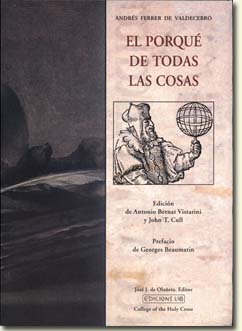|
Fray Andrés Ferrer de Valdecebro (1620-1680), better known for his treatises on animal symbology, belonged to the last generation of the authors of the great literature of the Spanish Golden Age. A member of the Order of Preachers, he had to orient his life and work in the direction of oratory and religious themes. However, his intellectual curiosity and ability to absorb like a sponge all different manners of knowledge of his period equipped him with a peculiar ability to synthesize his learnings. In those rather dark hours for Spanish science, a treatise with the ostentatious title of El porqué de todas las cosas could hide neither its limitations nor its transcendent objective. In spite of being a collection of questions and answers dedicated to themes of natural philosophy along the lines of the Aristotelian Problemata, the second part of the work reveals a separate didactic approach in which the hidden moral lesson is extracted from the functioning of nature or from the constitution of the human body, resorting at times even to certain aspects that at first glance might appear to be rather excessive or even surprising. The disjuncture between the two parts of the book makes it a precise metaphor for the state of Spanish culture towards the end of the seventeenth century: a dizzying display of scientific knowledge —for the most part already present in the Middle Ages— and a search for ultimate metaphysical explication imbued with a profound moral pessimism so typical of the Hispanic Baroque.
We offer as an example the five questions (Q) that make up chapter IV (60-65) with his responses (R) and a summary of our notes (*).
|
|

Chapter IV. «On monsters»*
60.
Q.- Why are monsters born on earth?
R.- There are many causes, such as the following: weakness or excessive abundance in the generative efficacy* an accident in the womb; powerful and lively apprehension,* the constellations* and special influence.*
61.
Q.- Why are there no longer giants like in centuries past?
R.- Because nature is already in its last swoons, without the strength and vigour to engender them, although there is a nation in the Orient that is of a gigantic nature.*
62.
Q.- Why are eunuchs monsters?
R.- Because they are neither male nor female?*
63.
Q.- Why are men not born with tails like the other animals?
R.- Because men sit down and they could not sit down if they had a tail. There is a certain Hebrew lineage that has them and they are born with little tails.*
64.
Q.- Why do eunuchs not have beards?
R.- Because due to the great abundance of mucus that they have, they are very cold, and with the lack of heat their pores are closed and obstructed.*
65.
Q.- Why do all eunuchs have soprano voices?
R.- Because the pulmonary tube receives little air and is very soft and subtle, and therefore, the voice emerges in this way. And because the great amount of wetness and mucus obstructs the channels and organ of the voice, in the same way that those whose voice is normally deep speak with a high pitch when they have a cold. And since the voice comes out of a very narrow opening, it comes out in a delicate and subtle manner. The same effect is seen in clarinets, oboes and cornets.*
|